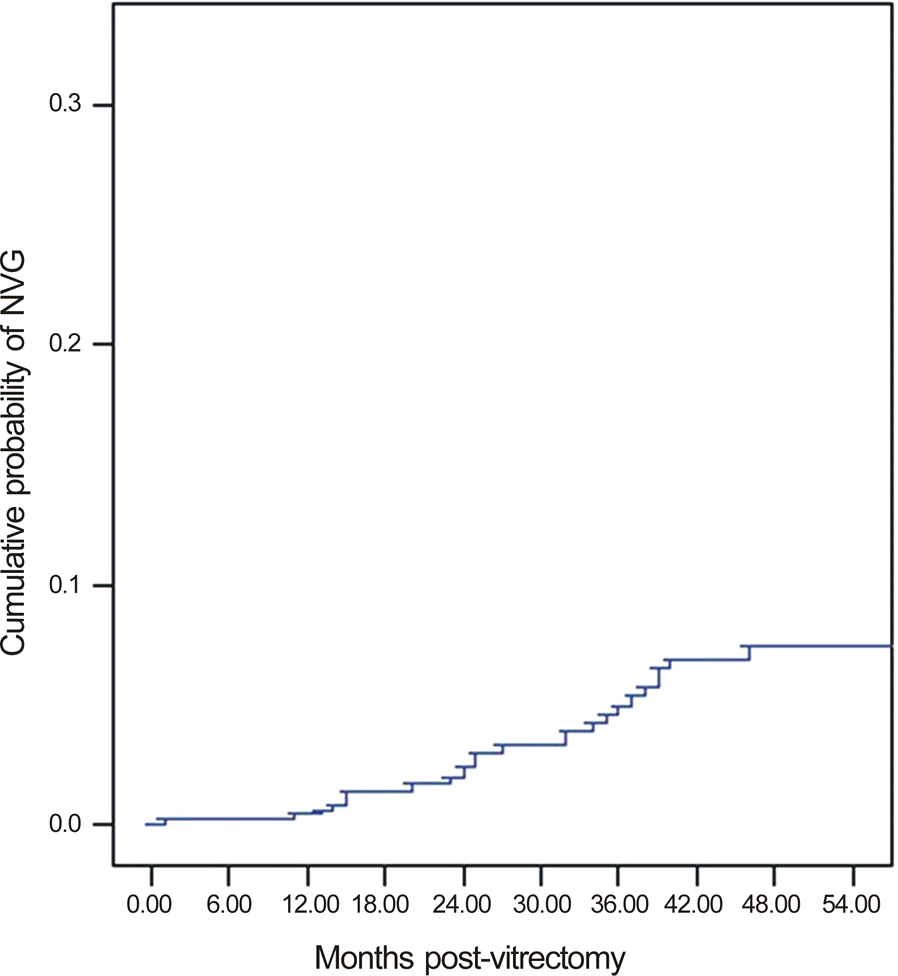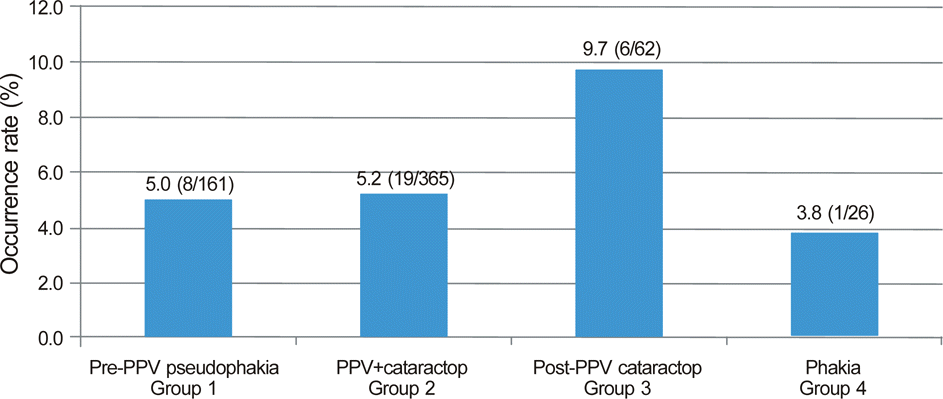Abstract
Purpose
The use of pre- and intraoperative vitreous bevacizumab injection and combined lens extraction with vitrectomy in patients with proliferative diabetic retinopathy (PDR) is increasing. In this study we analyzed the incidence and risk factors of neovascular glaucoma (NVG) after vitrectomy for PDR.
Methods
Patients who underwent vitrectomy for PDR from January 2004 to June 2011 were retrospectively reviewed. The minimum follow-up was 12 months. The cumulative incidence of NVG was calculated using the Kaplan-Meier survival analysis. The patients were divided into 4 groups according to lens status (preoperative pseudophakic group, simulta-neous cataract surgery group, sequential cataract surgery group, non-cataract surgery group). The differences in incidence between the groups were determined by the Chi-square test. Finally, to analyze the risk factors associated with the occurrence of NVG, the Cox's regression model was used.
Results
Of the 614 eyes (402 patients), 284 were males and 330 were females. The mean age was 55.8 ± 10.46 years (range 30-81 years) and the mean follow-up period was 36.6 months (range 1-93 months). Thirty-four of 614 patients (5.5%) developed postoperative NVG after vitrectomy. The probability of NVG occurrence at 6 and 12 months after vitrectomy was 0.7% and 2.5%, respectively. The incidence between the 4 groups did not show a statistically significant difference. The risk factors for postoperative NVG were male gender (RR = 3.01 p = 0.004), preoperative intravitreal bevacizumab injection (RR = 7.20, p < 0.001), and reoperation (RR = 3.18, p = 0.0037).
References
1. Machemer R, Buettner H, Norton EW, Parel JM. Vitrectomy: a pars plana approach. Trans Am Acad Ophthalmol Otolaryngol. 1971; 75:813–20.
2. Flynn HW Jr, Chew EY, Simons BD. . Pars plana vitrectomy in the Early Treatment Diabetic Retinopathy Study. ETDRS report number 17. The Early Treatment Diabetic Retinopathy Study Research Group. Ophthalmology. 1992; 99:1351–7.
3. Rice TA, Michels RG, Maguire MG, Rice EF. The effect of lensec-tomy on the incidence of iris neovascularization and neovascular glaucoma after vitrectomy for diabetic retinopathy. Am J Ophthalmol. 1983; 95:1–11.

4. Helbig H, Kellner U, Bornfeld N, Foerster MH. Rubeosis iridis af-ter vitrectomy for diabetic retinopathy. Graefes Arch Clin Exp Ophthalmol. 1998; 236:730–3.

5. Aaberg TM. Pars plana vitrectomy for diabetic traction retinal detachment. Ophthalmology. 1981; 88:639–42.

6. Blankenship G. Preoperative iris rubeosis and diabetic vitrectomy results. Ophthalmology. 1980; 87:176–82.

7. No authors listed. Early vitrectomy for severe vitreous hemorrhage in diabetic retinopathy. Four-year results of a randomized trial: Diabetic Retinopathy Vitrectomy Study Report 5. Arch Ophthalmol. 1990; 108:958–64.
8. Summanen P. Neovascular glaucoma following vitrectomy for dia-betic eye disease. Acta Ophthalmol (Copenh). 1988; 66:110–6.

9. Goto A, Inatani M, Inoue T. . Frequency and risk factors for ne-ovascular glaucoma after vitrectomy in eyes with proliferative dia-betic retinopathy. J Glaucoma. 2013; 22:572–6.

10. Bhatnagar P, Schiff WM, Barile GR. Diabetic vitrectomy: the in-fluence of lens status upon surgical outcomes. Curr Opin Ophthalmol. 2008; 19:243–7.

11. Schiff WM, Barile GR, Hwang JC. . Diabetic vitrectomy: influence of lens status upon anatomic and visual outcomes. Ophthalmology. 2007; 114:544–50.
12. Lahey JM, Francis RR, Kearney JJ. Combining phacoemulsifica-tion with pars plana vitrectomy in patients with proliferative dia-betic retinopathy: a series of 223 cases. Ophthalmology. 2003; 110:1335–9.
13. Kadonosono K, Matsumoto S, Uchio E. . Iris neovascularization after vitrectomy combined with phacoemulsification and intra-ocular lens implantation for proliferative diabetic retinopathy. Ophthalmic Surg Lasers. 2001; 32:19–24.

14. Chaudhry NA, Cohen KA, Flynn HW Jr, Murray TG. Combined pars plana vitrectomy and lens management in complex vitreor-etinal disease. Semin Ophthalmol. 2003; 18:132–41.

15. Takihara Y, Inatani M, Fukushima M. . Trabeculectomy with mitomycin C for neovascular glaucoma: prognostic factors for sur-gical failure. Am J Ophthalmol. 2009; 147:912–8.

16. Yazdani S, Hendi K, Pakravan M. . Intravitreal bevacizumab for neovascular glaucoma: a randomized controlled trial. J Glaucoma. 2009; 18:632–7.
17. Wand M, Madigan JC, Gaudio AR, Sorokanich S. Neovascular glaucoma following pars plana vitrectomy for complications of di-abetic retinopathy. Ophthalmic Surg. 1990; 21:113–8.

18. Wakabayashi Y, Usui Y, Okunuki Y. . Intraocular VEGF level as a risk factor for postoperative complications after vitrectomy for proliferative diabetic retinopathy. Invest Ophthalmol Vis Sci. 2012; 53:6403–10.

19. Spaide RF, Fisher YL. Intravitreal bevacizumab (Avastin) treat-ment of proliferative diabetic retinopathy complicated by vitreous hemorrhage. Retina. 2006; 26:275–8.

20. Sato T, Morita S, Bando H. . Early vitreous hemorrhage after vitrectomy with preoperative intravitreal bevacizumab for pro-liferative diabetic retinopathy. Middle East Afr J Ophthalmol. 2013; 20:51–5.

21. Lo WR, Kim SJ, Aaberg TM Sr. . Visual outcomes and in-cidence of recurrent vitreous hemorrhage after vitrectomy in dia-betic eyes pretreated with bevacizumab (avastin). Retina. 2009; 29:926–31.

22. Oshima Y, Shima C, Wakabayashi T. . Microincision vi-trectomy surgery and intravitreal bevacizumab as a surgical ad-junct to treat diabetic traction retinal detachment. Ophthalmology. 2009; 116:927–38.

Table 1.
Demographic characteristics
Table 2.
Chi-square test between 4 groups according to lens status
| p-value | Group 2 | Group 3 | Group 4 |
|---|---|---|---|
| Group 1 | 0.244 | 1.0 | 1.0 |
| Group 2 | - | 0.669 | 0.221 |
| Group 3 | - | - | 1.0 |
Table 3.
Univariate analysis of risk factors for neovascular glaucoma after vitrectomy in patients with proliferative diabetic retinopathy
Table 4.
Multivariate analysis of risk factors for neovascular glaucoma after vitrectomy in patients with proliferative diabetic retinopathy




 PDF
PDF ePub
ePub Citation
Citation Print
Print




 XML Download
XML Download